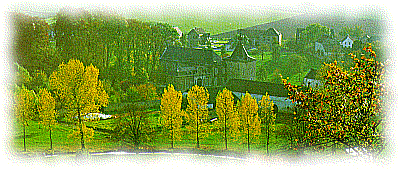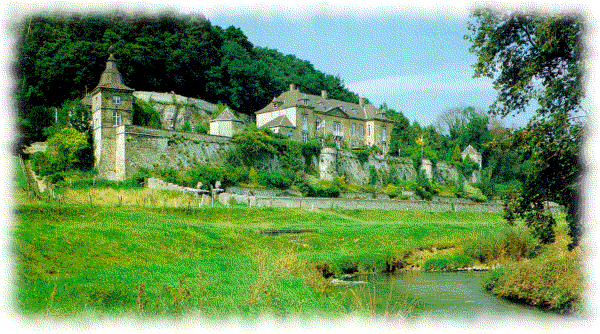![[Southern Limburg]](../images/southernlimburg.gif)
![[Southern Limburg]](../images/southernlimburg.gif)
 In the direct vicinity of Maastricht are the uplands of Southern Limburg.
Characteristic features of its landscape are the wooded hillsides and flatter
areas under arable cultivation and cattle rearing. The region still contains
many rustic villages, such as Schin op Geul, Noorbeek, Epen and Slenaken. Many
of the houses are half-timbered (i.e. timber-framed with mud walls) or built in
local maristone. It is outstanding walking country with a rich fauna and flora.
The type of vegetation is greatly influenced by the chalky soils and many
species unknown in the rest of the Netherlands can be found here. On the slopes
of the St. Pietersberg and in the Gerendal valley the chalk grasslands even
support orchids. The region is home to many chateaux which often grew around an
old central tower where the lord or master once resided. The later additions to
theses castles made them architecturally interesting and a number now house
hotels or restaurants. The close proximity of Maastricht to Belgium and
Germany gives it a special atmosphere. Five other cities lie within a radius of
30 km all showing similarities with each other, but separate identities too.
These are the so-called MHAHL cities: Maastricht, Heerlen, Aachen, Hasselt and
Liège. The tourist boards of these cities cooperate with each other in tourism
and recreation.
In the direct vicinity of Maastricht are the uplands of Southern Limburg.
Characteristic features of its landscape are the wooded hillsides and flatter
areas under arable cultivation and cattle rearing. The region still contains
many rustic villages, such as Schin op Geul, Noorbeek, Epen and Slenaken. Many
of the houses are half-timbered (i.e. timber-framed with mud walls) or built in
local maristone. It is outstanding walking country with a rich fauna and flora.
The type of vegetation is greatly influenced by the chalky soils and many
species unknown in the rest of the Netherlands can be found here. On the slopes
of the St. Pietersberg and in the Gerendal valley the chalk grasslands even
support orchids. The region is home to many chateaux which often grew around an
old central tower where the lord or master once resided. The later additions to
theses castles made them architecturally interesting and a number now house
hotels or restaurants. The close proximity of Maastricht to Belgium and
Germany gives it a special atmosphere. Five other cities lie within a radius of
30 km all showing similarities with each other, but separate identities too.
These are the so-called MHAHL cities: Maastricht, Heerlen, Aachen, Hasselt and
Liège. The tourist boards of these cities cooperate with each other in tourism
and recreation.

Château Neercanne is one of the most beautiful located and famous restaurants of the Netherlands. Located in the beautiful valley of the Jeker, this uniquely terraced château preserves a rich cultural and culinary tradition. The restaurant's cuisine française is renowned in the Netherlands as well as abroad, and offers a great variety of seasonal and country specialties. In the Roman caves near the château, there is a beautiful wine cellar in which many bottles are ripening under the best conditions.